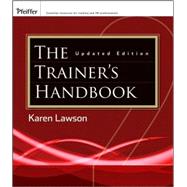
Karen Lawson, Ph.D., is an international consultant, speaker, and author. As founder and president of Lawson Consulting Group, Inc., she is the author of Leadership Development Basics, The Art of Influencing, Improving Workplace Performance Through Coaching, Improving On-the-Job Training and Coaching, SkillBuilders: 50 Communication Skills Activities, New Employee Orientation Training, and Involving Your Audience—Make It Active. She is coauthor of 101 Ways to Make Training Active (first edition) and has published dozens of articles in professional journals.
| List of Tables, Exhibits, and Figures | |
| Contents of theWebsite | |
| Acknowledgments | |
| Introduction | |
| Assessing Needs | |
| Learning Outcomes | |
| Understanding the Needs Assessment Process | |
| Needs-Assessment Process | |
| How to Conduct a Needs Assessment | |
| Developing an Action Plan | |
| Assessing Participants Knowledge, Attitudes, Skills | |
| Key Points | |
| Understanding | |
| Adult Learners | |
| Learning Outcomes | |
| AndragogicalVersus Pedagogical Model | |
| Understanding How andWhy People Learn | |
| Learning Styles | |
| Application of Learning Principles | |
| Key Points | |
| Training Styles | |
| Learning Outcomes | |
| Trainer Characteristics and Competencies | |
| Training Style | |
| Increasing Effectiveness | |
| Learner-CenteredVersus Information-Centered | |
| Key Elements of a Trainer's Style | |
| Key Points | |
| UnderstandingToday's Learner | |
| Learning Outcomes | |
| The Changing Training Environment | |
| Self-Awareness | |
| Diversity Issues | |
| Key Points | |
| Writing Instructional Objectives | |
| Learning Outcomes | |
| What Are Learning Objectives? | |
| Writing Learning Objectives | |
| Key Points | |
| Writing an Instructional Plan | |
| Learning Outcomes | |
| Design Philosophy | |
| Time Needed to Develop a Training Program | |
| Cost Considerations | |
| Major Components of Design | |
| Creating a Design Matrix | |
| Purpose of an Instructional Plan | |
| Components of an Instructional Plan | |
| Instructional Methods | |
| Developing Materials | |
| Key Points | |
| Selecting,Designing, and Developing | |
| Active-Training Methods | |
| Learning Outcomes | |
| The Case for Active Training | |
| Cooperative Learning | |
| Creating an Active-Learning Environment | |
| Designing Active-Training Activities | |
| Common Methods and Materials | |
| Experiential Learning Activities | |
| Action Learning | |
| Key Points | |
| DeliveringTraining | |
| Learning Outcomes | |
| Creating a Positive Learning Environment | |
| Experiential and Active-Training Techniques | |
| Tips for Using Specific Methods | |
| Improving Platform Presence | |
| Key Points | |
| UsingVisualAids | |
| Learning Outcomes | |
| Retention Rate inVisual Learning | |
| Why UseVisual Aids? | |
| Guidelines for UsingVisual Aids | |
| Other Commonly UsedVisual Aids | |
| Key Points | |
| Distance Learning | |
| Learning Outcomes | |
| Workplace Trends | |
| Advantages Benefits of Distance Learning | |
| Disadvantages Drawbacks to Distance Learning | |
| Types of Distance Learning | |
| Guidelines for Designing Distance Learning | |
| Designing and Developing Activities | |
| Delivering Content and Activities | |
| Blended Learning | |
| Key Points | |
| Working with Groups | |
| Learning Outcomes | |
| The Trainer as Facilitator | |
| Ways to Encourage Participation | |
| The Art of Questioning | |
| Responding to Questions | |
| Scaling theWall of Resistance | |
| Problem Situations | |
| Key Points | |
| Using Creativity | |
| Learning Outcomes | |
| Creativity with Small Groups | |
| Props and Other Theatrical Techniques | |
| Table of Contents provided by Publisher. All Rights Reserved. |
The New copy of this book will include any supplemental materials advertised. Please check the title of the book to determine if it should include any access cards, study guides, lab manuals, CDs, etc.
The Used, Rental and eBook copies of this book are not guaranteed to include any supplemental materials. Typically, only the book itself is included. This is true even if the title states it includes any access cards, study guides, lab manuals, CDs, etc.